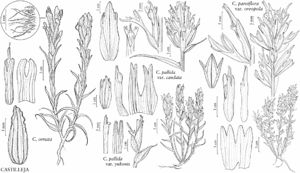Castilleja pallida var. caudata
Naturaliste Canad. 79: 320. 1952.
Herbs biennial or short-lived perennial. Stems glabrate or hairs appressed proximally, spreading distally, medium length proximally, longer distally, eglandular. Leaves lanceolate to linear-lanceolate, rarely linear, (1.5–) 5–7 (–9) cm, apex acuminate, caudate, or acute, sometimes obtuse; lobe apex acute to obtuse. Inflorescences 2–16 cm; bracts yellow, cream, or greenish yellow throughout, sometimes proximally green or dull purple, proximal few lanceolate, most broadly lanceolate to ovate. Calyces proximally pale green to redbrown or purple, distally colored as bracts, 12–13 mm; abaxial clefts 7–7.8 mm, adaxial 8.4–12.1 mm, clefts 50–60% of calyx length, lateral (1.5–) 3–4 (–7) mm, 20–40% of calyx length; lobes linear, sometimes triangular. Corollas slightly curved, 22–26 mm; tube 14–16 mm; beak margins white and often also deep purple or redbrown, or yellowish; abaxial lip with 1–3 of the colors green, purple, white, cream, or rose red, as a solid color or in 2 or 3 horizontal layers, 3–4 mm. 2n = 72.
Phenology: Flowering Jun–Aug(–Sep).
Habitat: Moist tundra, peatlands, stream banks, forests, bluffs, terraces, roadsides.
Elevation: 0–1700 m.
Distribution
B.C., N.W.T., Nunavut, Yukon, Alaska, ne Asia
Discussion
Variety caudata is both widespread and variable throughout much of Alaska and enters western and northern Yukon and into extreme northern British Columbia. The precise eastern extent of its range is incompletely known, especially since it is often similar to and easily confused with both var. yukonis and northern variants of Castilleja elegans and C. raupii. It apparently occurs in far northeastern Asia, but its status and distribution there is incompletely understood. See additional notes for this form under 81. C. pallida.
Selected References
None.
Lower Taxa
"dm" is not declared as a valid unit of measurement for this property.
